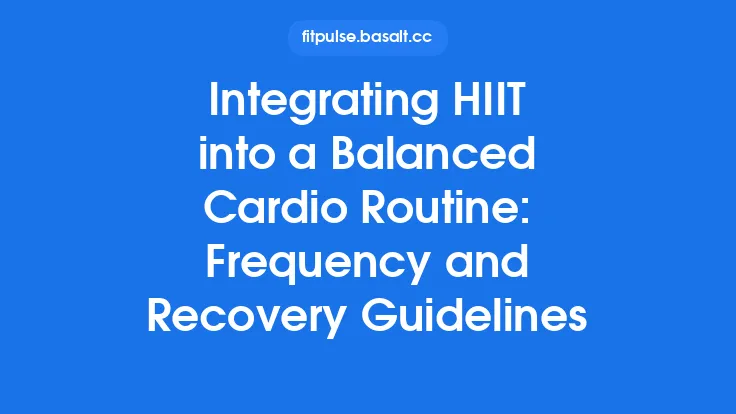Integrating LISS Cardio into a Full‑Body Training Program
Low‑intensity steady‑state (LISS) cardio is often viewed as a peripheral component of a strength‑oriented routine, yet when woven thoughtfully into a full‑body training program it can enhance work capacity, support body‑composition goals, and improve overall training quality. The key lies not in treating LISS as an isolated activity, but in positioning it strategically alongside resistance work, periodizing its volume and intensity, and aligning it with nutrition and recovery protocols. Below is a comprehensive guide to embedding LISS into a holistic training regimen while preserving the primary objectives of strength, hypertrophy, or general fitness.
Understanding the Role of LISS in Concurrent Training
Concurrent training—simultaneously developing muscular and aerobic capacities—creates a unique set of adaptive demands. LISS occupies a middle ground between high‑intensity interval work and complete rest, offering several functional benefits that complement resistance training:
| Benefit | How It Supports Full‑Body Training |
|---|---|
| Enhanced Mitochondrial Density | Improves the muscle’s ability to generate ATP aerobically, which can delay fatigue during high‑volume lifting sessions. |
| Increased Capillary Perfusion | Facilitates nutrient and oxygen delivery to working muscles, supporting recovery between sets and across training days. |
| Improved Substrate Utilization | Encourages the body to oxidize a higher proportion of fat during prolonged activity, preserving glycogen stores for strength work. |
| Cardiovascular Reserve | Elevates stroke volume and cardiac output, allowing athletes to sustain higher training loads without excessive heart‑rate spikes. |
| Psychological Buffer | Provides a low‑stress cardio option that can be used on “light” days, maintaining routine consistency without adding mental fatigue. |
By recognizing these contributions, coaches and athletes can treat LISS as a purposeful tool rather than a filler activity.
Sequencing LISS and Resistance Sessions – When to Do What
The order in which LISS and resistance work are performed influences acute performance and long‑term adaptations. Two primary sequencing models are commonly employed:
- LISS After Resistance (Post‑Lift Cardio)
Advantages
- Preserves maximal strength and power output for the primary lift session.
- Allows the athlete to capitalize on the post‑exercise “afterburn” (excess post‑exercise oxygen consumption, EPOC) while the metabolic rate is already elevated.
Considerations
- Extended cardio duration (>45 min) may impair subsequent recovery if not managed with adequate nutrition.
- LISS Before Resistance (Pre‑Lift Cardio)
Advantages
- Serves as an active warm‑up, increasing muscle temperature and joint lubrication.
- Can be useful on days when the primary goal is technique refinement rather than maximal load.
Considerations
- Even low‑intensity work can deplete glycogen modestly, potentially reducing performance on heavy compound lifts.
Practical Recommendation: For most strength‑focused programs, schedule LISS after the resistance component, limiting the cardio session to 20–30 minutes at a truly low intensity (≈50–60 % of maximal heart rate). On “technique” or “deload” days, a brief pre‑lift LISS (10–15 minutes) can double as a warm‑up.
Periodizing LISS Within Macro‑ and Mesocycles
Just as resistance volume and intensity are cycled, LISS should be periodized to align with the broader training plan. Below is a three‑phase framework that can be adapted to any macrocycle length (e.g., 12‑week block).
| Phase | Primary Goal | LISS Volume (minutes/week) | LISS Intensity (HR% max) | Integration Strategy |
|---|---|---|---|---|
| Accumulation (Weeks 1‑4) | Build work capacity, reinforce movement patterns | 90–120 | 55–60 | LISS placed after most strength sessions; occasional “cardio‑only” days to increase total aerobic stimulus. |
| Intensification (Weeks 5‑8) | Emphasize maximal strength or hypertrophy | 60–90 | 55–60 | Reduce LISS frequency to 2‑3 sessions/week; keep duration ≤30 min to limit interference. |
| Realization / Taper (Weeks 9‑12) | Sharpen performance, allow super‑compensation | 30–45 | 55–60 | LISS limited to 1‑2 short sessions (15‑20 min) to maintain cardiovascular tone without taxing recovery. |
Key Points for Periodization
- Volume Manipulation: Adjust total weekly minutes rather than drastically changing intensity; this preserves the low‑stress nature of LISS.
- Microcycle Placement: Within a given week, schedule LISS on days where the resistance load is lighter (e.g., upper‑body push day followed by lower‑body pull day with LISS after the latter).
- Deload Weeks: Maintain a minimal LISS dose (≈15 min) to keep the aerobic system active while allowing full muscular recovery.
Balancing Volume and Intensity to Mitigate the Interference Effect
The “interference effect” describes the potential attenuation of strength gains when aerobic work is performed concurrently. While LISS is less likely to provoke this phenomenon than high‑intensity cardio, careful balancing is still required.
- Total Weekly Training Load
- Calculate a training stress score (TSS) for both resistance and LISS components. Aim for a ratio where resistance TSS constitutes at least 60 % of the total weekly load.
- Example: 4 resistance sessions (TSS ≈ 300) + 3 LISS sessions (TSS ≈ 90) yields a 77 % resistance dominance, a safe zone for strength preservation.
- Intensity Distribution
- Keep LISS heart‑rate zones firmly within the fat‑oxidation/low‑stress band (≈50‑60 % HRmax). This minimizes activation of competing molecular pathways (e.g., AMPK vs. mTOR) that could blunt hypertrophy.
- Recovery Allocation
- Ensure at least 48 hours between heavy lower‑body sessions and any LISS that follows a lower‑body workout, especially if the cardio duration exceeds 30 minutes.
By monitoring these variables, athletes can reap the aerobic benefits of LISS while safeguarding strength and hypertrophy outcomes.
Nutritional Considerations for Integrated LISS Programs
Fueling strategies must reflect the dual demands of resistance training and low‑intensity cardio.
- Carbohydrate Timing
- Prioritize complex carbohydrates (e.g., oats, sweet potatoes) 1‑2 hours before resistance work to preserve glycogen for high‑intensity lifts.
- Post‑resistance, a protein‑carb blend (≈0.4 g protein + 0.5 g carb per kg body weight) supports glycogen replenishment and muscle repair, making the subsequent LISS session less taxing on recovery.
- Protein Distribution
- Aim for 0.3‑0.4 g protein per kg in each main meal, including the post‑LISS meal, to maintain a positive nitrogen balance throughout the day.
- Hydration
- Even low‑intensity sessions can lead to fluid loss, especially in warm environments. Replace electrolytes proportionally to sweat loss (≈0.5 L water per hour of LISS).
- Caloric Balance
- For fat‑loss phases, modestly reduce calories (≈10‑15 % deficit) while preserving protein intake; LISS can be used to increase total energy expenditure without compromising muscle mass.
- For muscle‑gain phases, maintain a slight surplus (≈5‑10 % above maintenance) and treat LISS as a “maintenance” cardio to keep cardiovascular health in check.
Sample Weekly Templates for Different Goals
Below are three adaptable weekly outlines. Each template assumes a four‑day full‑body resistance split (e.g., Monday, Tuesday, Thursday, Friday). Adjust days to fit personal schedules.
1. Strength‑Focused Template
| Day | Resistance | LISS | Notes |
|---|---|---|---|
| Mon | Full‑body (Heavy) | 20 min post‑lift (steady) | Keep HR ≤ 60 % max |
| Tue | Full‑body (Volume) | 15 min light walk (active recovery) | Optional, can be omitted |
| Wed | Rest or mobility | — | No cardio |
| Thu | Full‑body (Heavy) | 20 min post‑lift | Same intensity as Mon |
| Fri | Full‑body (Volume) | 15 min light bike | Keep session ≤30 min |
| Sat | Optional skill work | 30 min easy hike (optional) | Use only if fully recovered |
| Sun | Rest | — | Full recovery |
Key: LISS volume totals ~70 min/week, preserving a high resistance‑dominant load.
2. Hypertrophy‑Focused Template
| Day | Resistance | LISS | Notes |
|---|---|---|---|
| Mon | Upper‑body push + lower‑body pull | 25 min post‑lift | Moderate volume |
| Tue | Lower‑body push + upper‑body pull | 25 min post‑lift | Same duration |
| Wed | Rest or active mobility | — | No cardio |
| Thu | Full‑body hypertrophy (moderate load) | 20 min post‑lift | Slightly shorter |
| Fri | Optional accessory work | 20 min light elliptical | Keep HR low |
| Sat | Rest or light activity | — | Recovery day |
| Sun | Optional family walk | 30 min easy | Pure enjoyment |
Key: LISS totals ~90 min/week, balanced across the week to avoid excessive fatigue.
3. General‑Fitness / Body‑Composition Template
| Day | Resistance | LISS | Notes |
|---|---|---|---|
| Mon | Full‑body (moderate) | 30 min steady (post‑lift) | |
| Tue | Full‑body (moderate) | 30 min steady (post‑lift) | |
| Wed | Rest or yoga | — | |
| Thu | Full‑body (moderate) | 30 min steady (post‑lift) | |
| Fri | Full‑body (moderate) | 30 min steady (post‑lift) | |
| Sat | Outdoor activity (hike, bike) | 45 min easy | Optional, non‑structured |
| Sun | Rest | — |
Key: LISS totals ~120 min/week, providing a solid aerobic base while maintaining consistent strength stimulus.
Tracking Progress and Adjusting Variables
To ensure the integrated program remains effective, employ a systematic tracking approach:
- Performance Metrics
- Strength: Record weekly 1RM or 5RM for core lifts. A decline >5 % may signal excessive cardio fatigue.
- Endurance: Log LISS duration, perceived effort, and heart‑rate average. Gradual improvements in steady‑state speed or distance indicate aerobic adaptation.
- Recovery Indicators
- Resting HR: A sustained elevation (>5 bpm above baseline) suggests cumulative fatigue.
- Subjective Wellness: Use a simple 1‑10 scale for sleep quality, muscle soreness, and motivation.
- Adjustment Protocol
- If strength stalls: Reduce LISS volume by 10‑15 % for the next two weeks, or shift LISS to a separate day with a longer recovery window.
- If aerobic capacity plateaus: Increase LISS duration by 5‑10 minutes per session, keeping intensity constant.
- If body‑composition goals lag: Fine‑tune caloric intake first; if still stagnant, modestly raise LISS volume (up to 150 min/week) while monitoring strength metrics.
Regularly revisiting these data points—ideally every 4‑6 weeks—allows for evidence‑based tweaks without resorting to guesswork.
Common Pitfalls and How to Avoid Them
| Pitfall | Why It Happens | Prevention Strategy |
|---|---|---|
| Excessive LISS Duration | Treating cardio as “extra” mileage. | Cap weekly LISS at 120 min for most athletes; use a timer to stay within session limits. |
| High‑Intensity LISS (e.g., fast‑paced intervals) | Misinterpreting “steady‑state” as “fast”. | Keep pace conversational; monitor heart‑rate to stay within 50‑60 % HRmax. |
| Placing LISS Immediately Before Heavy Lifts | Habit of “warming up” with a long walk. | Limit pre‑lift cardio to 5‑10 minutes of dynamic movement; reserve longer LISS for post‑lift or separate days. |
| Neglecting Nutrition Around Cardio | Assuming LISS burns negligible calories. | Schedule protein‑carb meals within 2 hours of both resistance and LISS sessions. |
| Ignoring Individual Recovery Capacity | One‑size‑fits‑all programming. | Use personal recovery markers (resting HR, sleep) to adjust LISS volume on a weekly basis. |
| Over‑reliance on LISS for Fat Loss | Believing LISS alone will create a deficit. | Combine LISS with appropriate dietary control and resistance training for optimal body‑composition results. |
By proactively addressing these issues, athletes can maintain a harmonious balance between cardio and strength work.
Final Thoughts
LISS cardio, when integrated with intention, becomes more than a peripheral activity—it serves as a catalyst for improved work capacity, efficient substrate utilization, and sustained cardiovascular health, all while preserving the primary goals of a full‑body training program. The cornerstone of successful integration lies in strategic sequencing, periodized volume, balanced nutrition, and continuous monitoring. By applying the frameworks and templates outlined above, coaches and athletes can craft a cohesive regimen that leverages the low‑stress benefits of LISS without compromising strength, hypertrophy, or overall performance.





